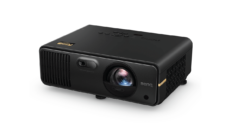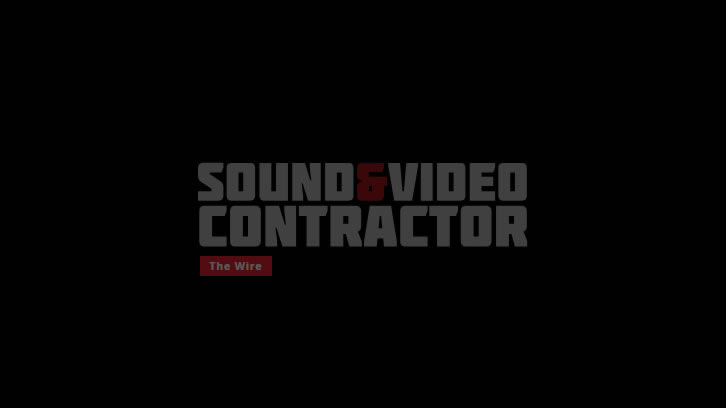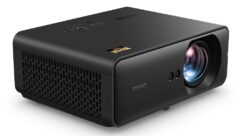Panasonic PT-AE700U LCD Projector
Peer Review: Panasonic PT-AE700U LCD Projector, Price $2,999
DesignPerformanceValueMANUFACTURER SPECIFICATIONS
Product:Panasonic PT-AE700U front LCD projector
Price: $2,999
Company website:www.panasonic.com/projectors
Plus: Excellent black levels; good color quality; long throw lens
Minus: Some image softness at times; poor composite video processing
PANASONIC’S PT-AE500U front LCD projector made waves in the fall of 2003 with its low price and improved color rendering. Now, Panasonic has followed up with the PT-AE700U, which is more than just an upgrade. It has some new bells and whistles of its own, including a longer-throw projection lens, auto iris circuitry for deeper blacks, and an optical system that minimizes the “screen door” effect so common to LCD projectors of all kinds.
The PT-AE700U offers a clean, simple layout with a minimal connector complement. The HDMI interface replaces an earlier DVI connector on the PT-AE500U and is strictly for use with DVD players and set-top receivers. You won’t find any on-board speakers or audio inputs and outputs.
You’ll also notice a joystick next to the lens on the front of the projector. It’s a dual-axis mechanical lens shift adjustment and it will let you shift images to fit your screen, depending on where the 2:1 zoom lens is set. (Panasonic opted to go with the long lens to give people more options in projector placement.)
The cooling fan, mounted to the side, is super-quiet but does dissipate a lot of heat. No worries, though — with a longer projection throw, there’s little chance you’d hear the projector or feel any of that warm air.
The supplied remote control has a simple layout with 18 different buttons. My only complaint about it is that you won’t have direct access to video inputs, which are grouped into three main categories (Video, Component, PC/HDMI).
There are plenty of image adjustments to be found in the PT-AE700U. You can cycle between as many as five different aspect ratio presets (4:3, 16:9, Just, Zoom, and Auto), and there’s also a digital keystone correction circuit if you don’t want to use the joystick.
Panasonic also includes seven factory-preset combinations of brightness, contrast, Gamma, and white balance (Natural, Cinema 1, Cinema 2, Cinema 3, Normal, Video, and Dynamic). There are also five preset color temperature selections to choose from.
The Advanced menu gives you access to three different picture Gamma settings, RGB contrast, and RGB brightness. You can also adjust brightness, hue, and saturation for any specific color and save those settings into user profiles, with a maximum of eight colors per profile.
When this projector was shown at Cedia Expo 2004, the super-low black levels caught everyone’s attention. Credit them to an advanced auto iris circuit, which acts continuously to adjust the projector’s dynamic range up and down as picture brightness levels change.
After calibration for best grayscale, I measured brightness at 758 ANSI lumens, compared to a manufacturer’s spec of 1,000 ANSI lumens. Brightness levels ran as high as 939 lumens in Dynamic mode and as low as 350 lumens in Cinema 1 mode, so you’ll have plenty of light available for a long-throw projection setup.
Brightness uniformity across the screen measured 73 percent, about average for an LCD projector. With a 720p test pattern, I measured contrast ratios of 272:1 ANSI (average) and 457:1 peak, while a 480i checkerboard produced readings of 251:1 ANSI and 394:1 peak. With a 50/50 black and white pattern, I measured peak contrast at 896:1.
This projector tracks a very clean grayscale right out of the box using the middle color temperature setting. After adjustment, I was able to shift the grayscale up slightly, but I can’t say I made a substantial improvement on Panasonic’s preset grayscale. In terms of picture quality, the PT-AE700U delivers mixed results. Panasonic used to have outstanding composite video processing in all of its display products, but appear to have given up on it in this projector. Using the Zone Plate from the Video Essentials DVD, I couldn’t see any image detail above 300 lines and the moving target was loaded with cross-color artifacts.
I was also disappointed in the quality of de-interlacing and motion correction through the S-video and component inputs. The waving flag, racecar, and spinning bar test patterns from the Silicon Optix HQV test DVD revealed lots of scan line artifacts, and the PT-AE700U was also slow to pick up on transitions from video to 3:2 film-to-video cadences.
The reason for this mediocre 480i performance could simply be an abundance of inexpensive progressive-scan DVD players. Indeed, playing back the same DVD sequences through my Panasonic RP56 DVD player in 480p mode cleaned up all the problems listed above.
The best-looking images were seen with 720p and 1080i content. Even though the projector doesn’t have quite enough bandwidth for full HD (rolling off picture detail above 18 MHz), the mix of films and live content had plenty of contrast and good color rendering. That auto iris circuit really works. In my tests, on average, black levels were 50 percent lower with it switched on, so I’d advise you to leave it turned on all of the time.
The PT-AE700U also excels with color reproduction. I spent a lot of time playing with the white balance and color saturation controls to get as close a match as possible to my reference Princeton AF3.0HD monitor, and the Panasonic projector has come closer than any other front LCD or DLP model I’ve tested.
While the red, green, and blue coordinates I measured are still offset from SMPTE “C” standard phosphors, I was quite pleased at how well flesh tones and pastel color shades matched up between the PT-AE700U and the Princeton monitor.
The PT-AE700U has its good points and bad points. It delivers really nice color and the highest contrast and lowest black levels I’ve ever seen in an LCD projector — my measurements were more typical of single-chip DLP designs. But its 480i performance is mediocre at best, which means you’ll need to use a good progressive-scan DVD player and/or outboard video scaler with the PT-AE700U to make it shine. The auto iris circuit really works and the optical system softens the “screen door” effect so it’s not apparent, although overall image quality is a tad softer as well. The extra bells and whistles, the extended color management system, and a retail price at just less than $3,000 more than make up for the inferior composite video processing and make this LCD projector an excellent value.
Imager: (3) 0.7-inch 1280×720 LCD panels
Lamp: 130 W UHP
Inputs: 1 composite, 1 S-video, 1 YPbPr, 1 15-pin RGB, 1 HDMI
Audio: None Lens: 21.7 – 43.1 mm zoom with mechanical lens shift
Dimensions (WxHxL): 13.2 x 4.1 x 10.6 inches
Weight: 7.9 pounds
Pete Putman is a contributing editor for Pro AV and president of ROAM Consulting, Doylestown, PA. Especially well known for the product testing/development services he provides manufacturers of projectors, monitors, integrated TVs, and display interfaces, he has also authored hundreds of technical articles, reviews, and columns for industry trade and consumer magazines over the last two decades. You can reach him at mmayfield@hanleywood.com









